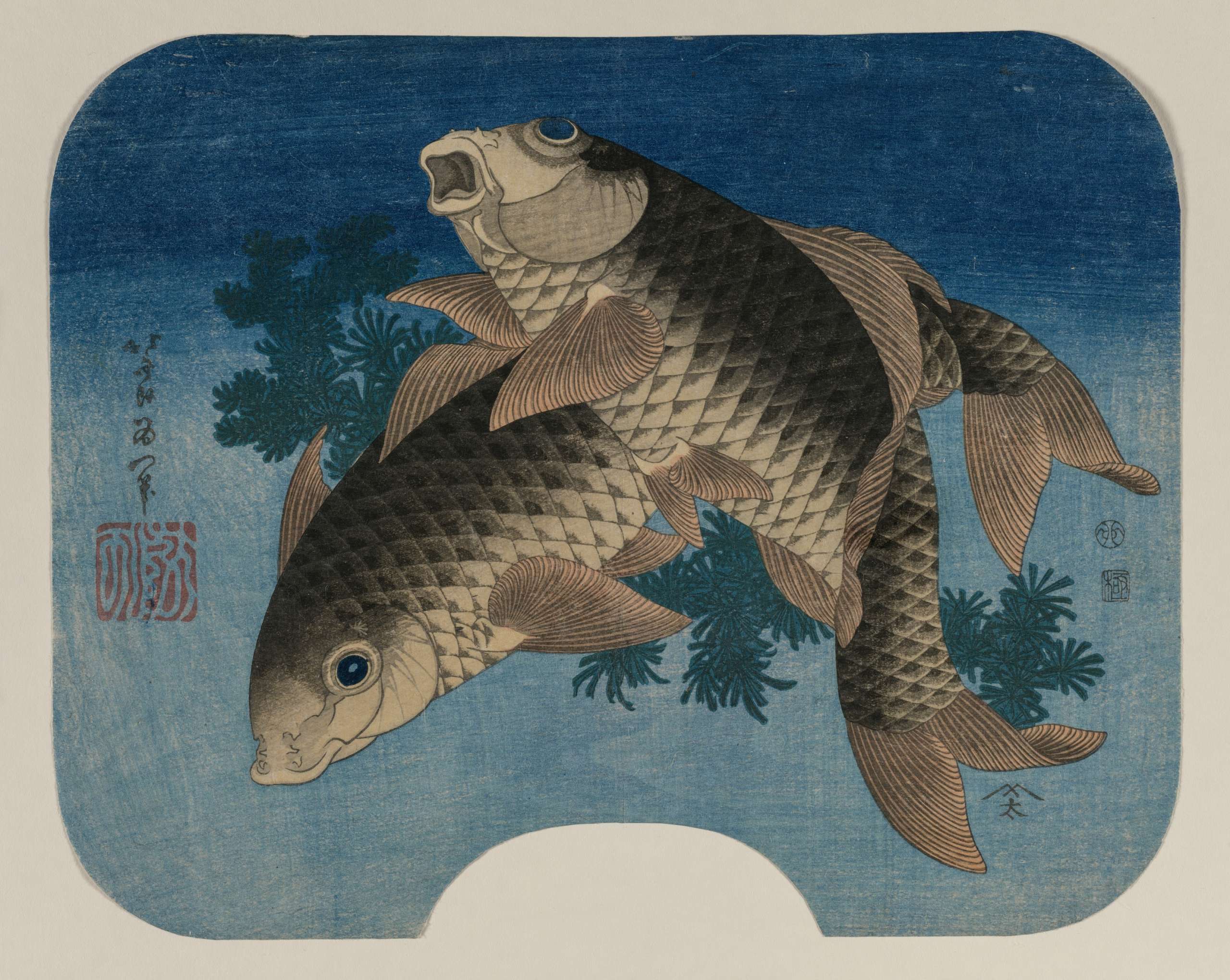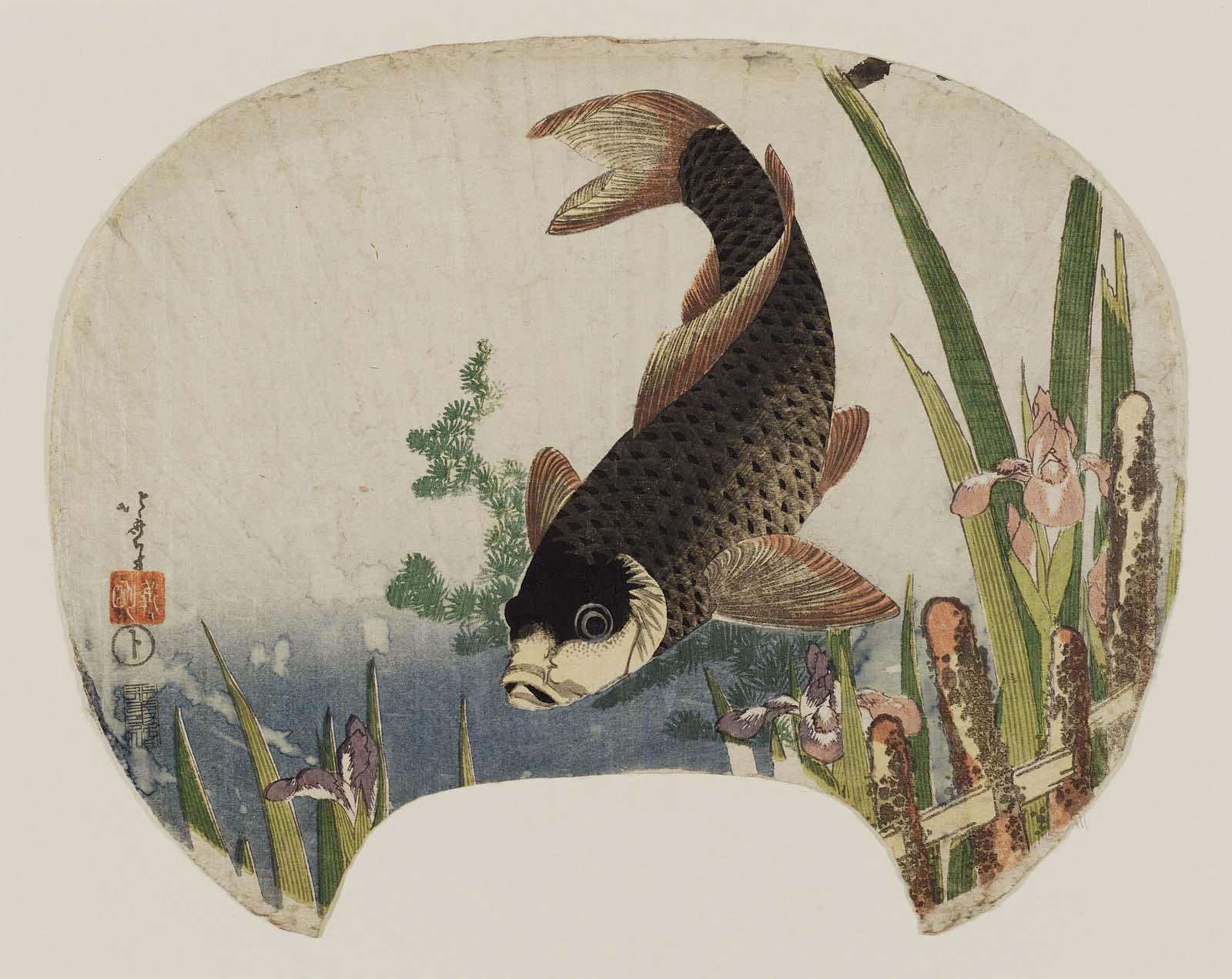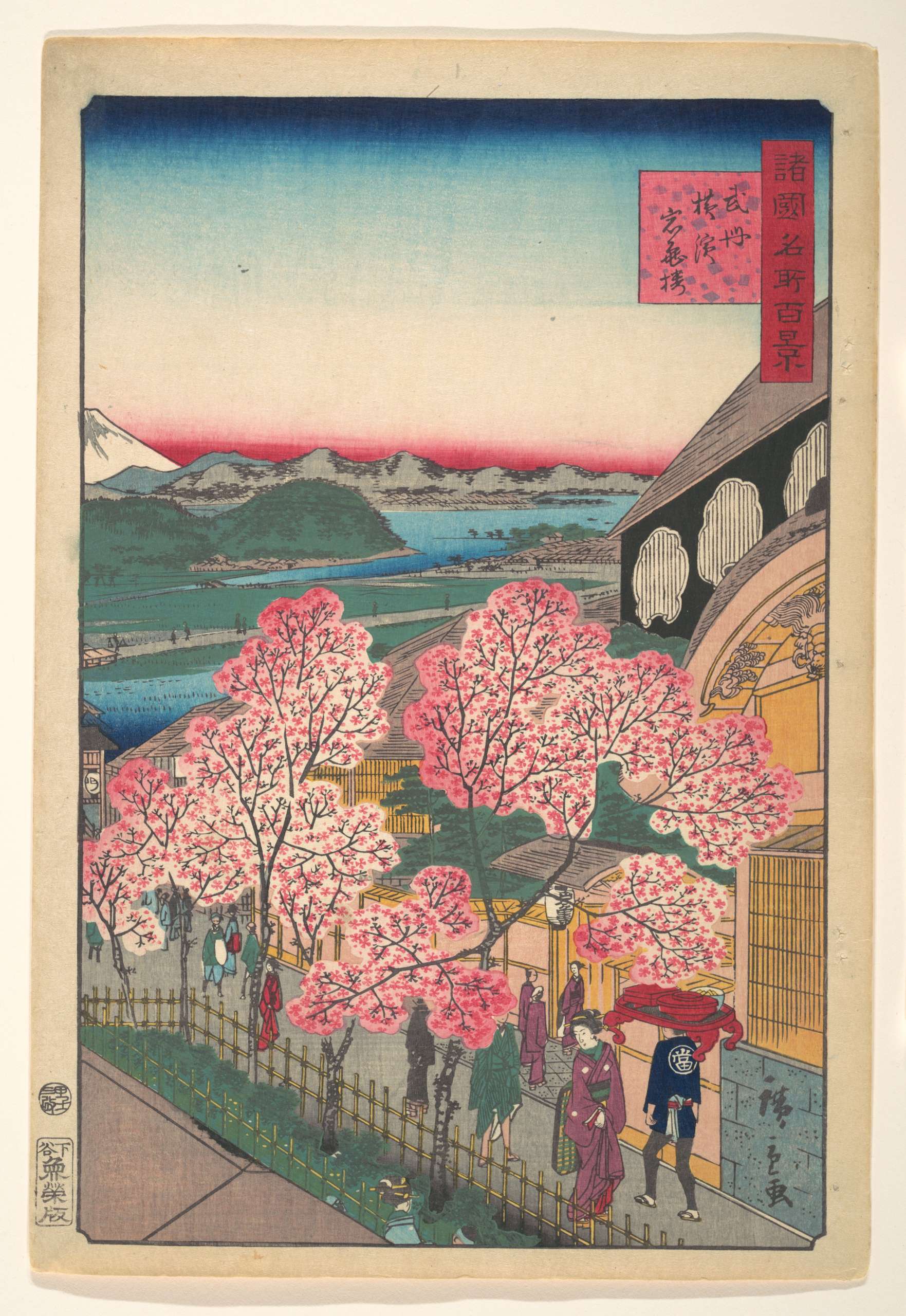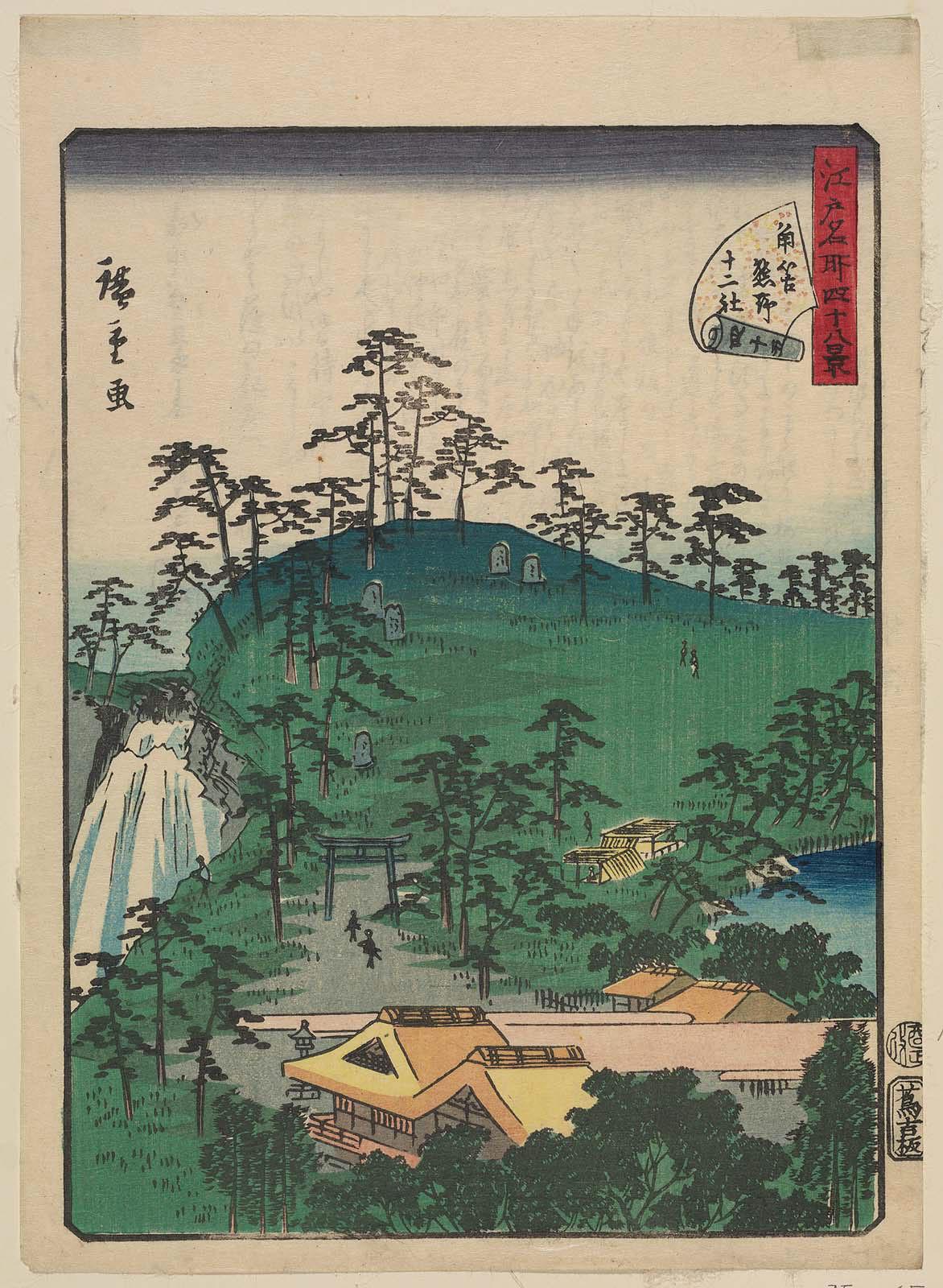-
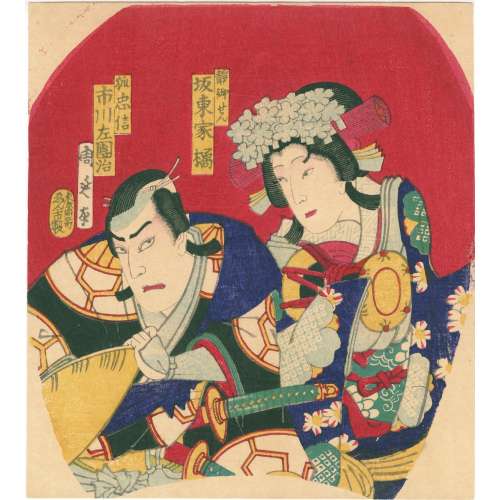 Artist: Toyohara Chikanobu [豊原周延] (Japanese, 1838 – 1912) Signed: Chikanobu ga [周延画] Publisher: [ 東京掘江町] Tokyo Horiemachi | [えん市製] Enshi-sei. Media: Fan print (uchiwa-e, 団扇絵), 192 x 172 mm. Actors: Female: Bandō Kakitsu I in the role of Shizuka Gozen [静御前]. Male: Ichikawa Sadanji I in the role of Kitsune Tadanobu [狐忠信], a.k.a. Satō Tadanobu [佐藤 忠信]. Bandō Kakitsu I [初代 坂東 家橘] (Japanese, 1847 – 1893); other names: Ichimura Kakitsu V, Ichimura Uzaemon XIV, Ichimura Kakitsu V, Ichimura Uzaemon XIV, Ichimura Takematsu III. Ichikawa Sadanji I [市川左団次] (Japanese, 1842 – 1904); other names: Ichikawa Shōjaku I, Ichikawa Koyone, Ichikawa Tatsuzō.
Artist: Toyohara Chikanobu [豊原周延] (Japanese, 1838 – 1912) Signed: Chikanobu ga [周延画] Publisher: [ 東京掘江町] Tokyo Horiemachi | [えん市製] Enshi-sei. Media: Fan print (uchiwa-e, 団扇絵), 192 x 172 mm. Actors: Female: Bandō Kakitsu I in the role of Shizuka Gozen [静御前]. Male: Ichikawa Sadanji I in the role of Kitsune Tadanobu [狐忠信], a.k.a. Satō Tadanobu [佐藤 忠信]. Bandō Kakitsu I [初代 坂東 家橘] (Japanese, 1847 – 1893); other names: Ichimura Kakitsu V, Ichimura Uzaemon XIV, Ichimura Kakitsu V, Ichimura Uzaemon XIV, Ichimura Takematsu III. Ichikawa Sadanji I [市川左団次] (Japanese, 1842 – 1904); other names: Ichikawa Shōjaku I, Ichikawa Koyone, Ichikawa Tatsuzō. -
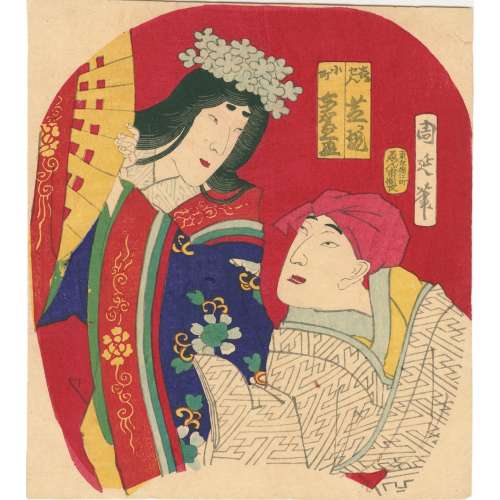 Artist: Toyohara Chikanobu [豊原周延] (Japanese, 1838 – 1912) Signed: Chikanobu hitsu [周延筆] Publisher: [ 東京掘江町] Tokyo Horiemachi | [えん市製] Enshi-sei. Media: Fan print (uchiwa-e, 団扇絵), 192 x 172 mm. Possibly Iwai Kumesaburō IV [岩井粂三郎] (1856 – 1886) a.k.a. Iwai Hisajirō III [岩井久次郎] in the role of Ono no Komachi [小野乃小町] and Nakamura Shikan IV [中村芝翫] in the role of Kisen Hōshi [喜せん法師]. Play: The Six Immortal Poets in Colorful Guises [六歌仙体綵] (Rokkasen Sugata no irodori). Inscription: Left: Kisen [喜せん] | Shikan [芝翫] Right: Komachi [小町] | Kumesaburō [粂三郎]. Actors: Iwai Kumesaburō IV [岩井粂三郎] (1856 – 1886) a.k.a. Iwai Hisajirō III [岩井久次郎]. Nakamura Shikan IV [中村芝翫] (Japanese, 1831 – 1899); other names: Nakamura Fukusuke I [中村福助], Nakamura Masanosuke I, Nakamura Komasaburō, Nakamura Tamatarō I.
Artist: Toyohara Chikanobu [豊原周延] (Japanese, 1838 – 1912) Signed: Chikanobu hitsu [周延筆] Publisher: [ 東京掘江町] Tokyo Horiemachi | [えん市製] Enshi-sei. Media: Fan print (uchiwa-e, 団扇絵), 192 x 172 mm. Possibly Iwai Kumesaburō IV [岩井粂三郎] (1856 – 1886) a.k.a. Iwai Hisajirō III [岩井久次郎] in the role of Ono no Komachi [小野乃小町] and Nakamura Shikan IV [中村芝翫] in the role of Kisen Hōshi [喜せん法師]. Play: The Six Immortal Poets in Colorful Guises [六歌仙体綵] (Rokkasen Sugata no irodori). Inscription: Left: Kisen [喜せん] | Shikan [芝翫] Right: Komachi [小町] | Kumesaburō [粂三郎]. Actors: Iwai Kumesaburō IV [岩井粂三郎] (1856 – 1886) a.k.a. Iwai Hisajirō III [岩井久次郎]. Nakamura Shikan IV [中村芝翫] (Japanese, 1831 – 1899); other names: Nakamura Fukusuke I [中村福助], Nakamura Masanosuke I, Nakamura Komasaburō, Nakamura Tamatarō I. -
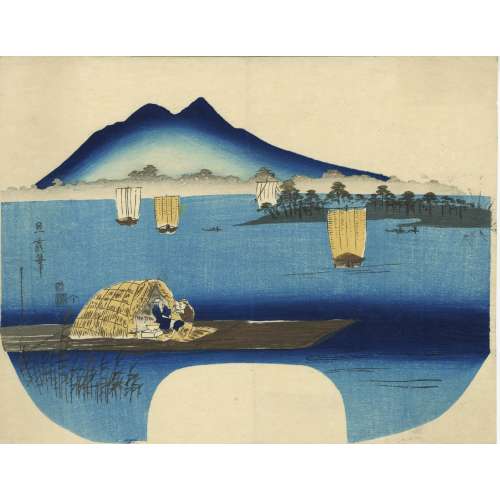 Artist: Tsukioka Tanka [旦霞] (Japanese, fl. c. 1830s – 1840s). Publisher: Enshūya Matabei [遠州屋又兵衛] (Japanese, fl. c. 1768 – 1881); seal: Enmata. Title: Picture of Fuji, Tsukuba and Sumida River [富士筑波隅田川の圖] (フジ ツクバ スミダガワ ノ ズ | Fuji Tsukuba Sumidagawa no zu). Date seal 巳 + kiwame: Tenpō 4 (1833). Media: Fan print (uchiwa-e, 団扇絵), 235 x 302 mm, aizuri-e. Only four prints are known from this artist, all fans: (1) National Diet Library 2542868:
Artist: Tsukioka Tanka [旦霞] (Japanese, fl. c. 1830s – 1840s). Publisher: Enshūya Matabei [遠州屋又兵衛] (Japanese, fl. c. 1768 – 1881); seal: Enmata. Title: Picture of Fuji, Tsukuba and Sumida River [富士筑波隅田川の圖] (フジ ツクバ スミダガワ ノ ズ | Fuji Tsukuba Sumidagawa no zu). Date seal 巳 + kiwame: Tenpō 4 (1833). Media: Fan print (uchiwa-e, 団扇絵), 235 x 302 mm, aizuri-e. Only four prints are known from this artist, all fans: (1) National Diet Library 2542868:
(2) Ritsumeikan University mai30_07: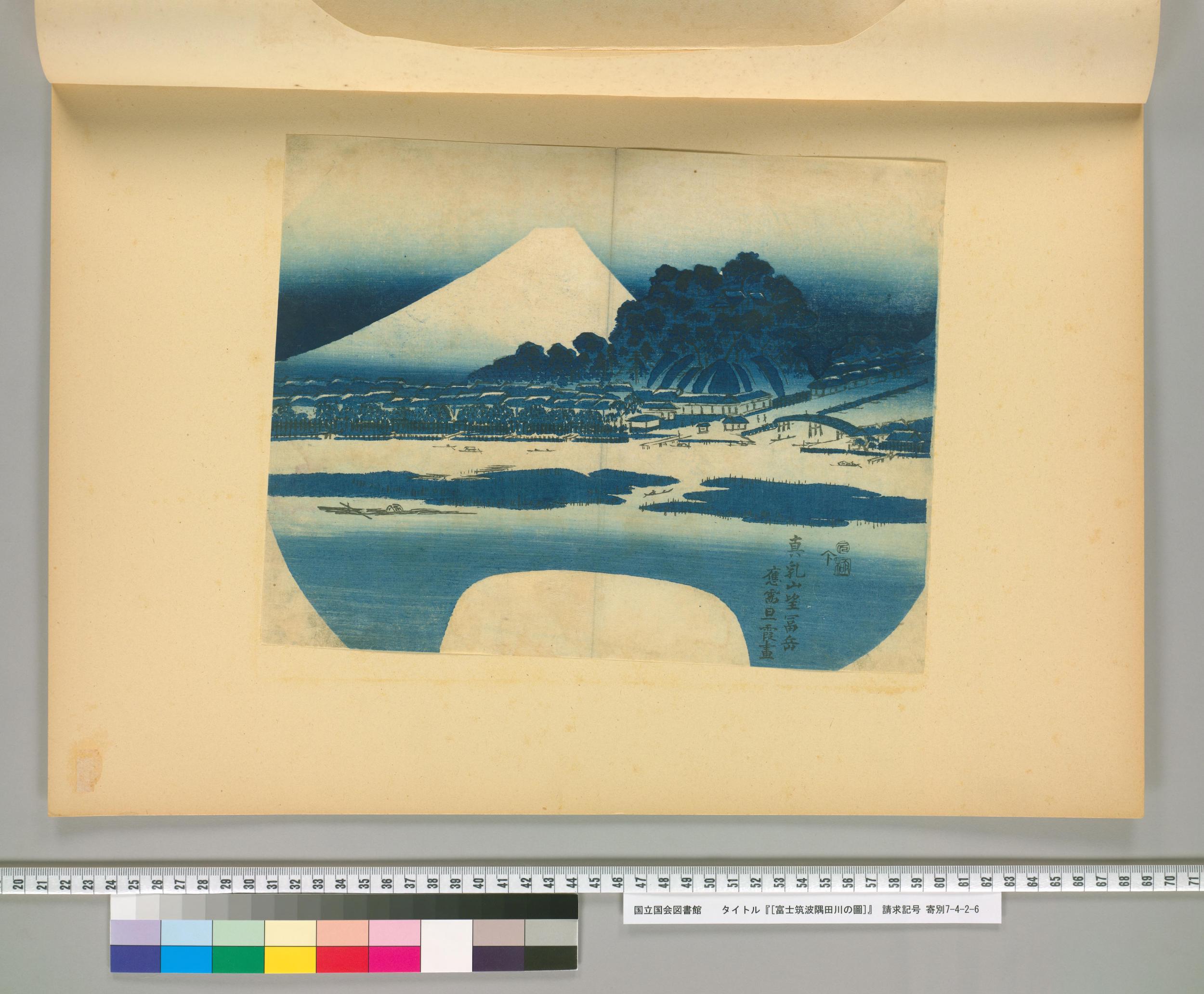
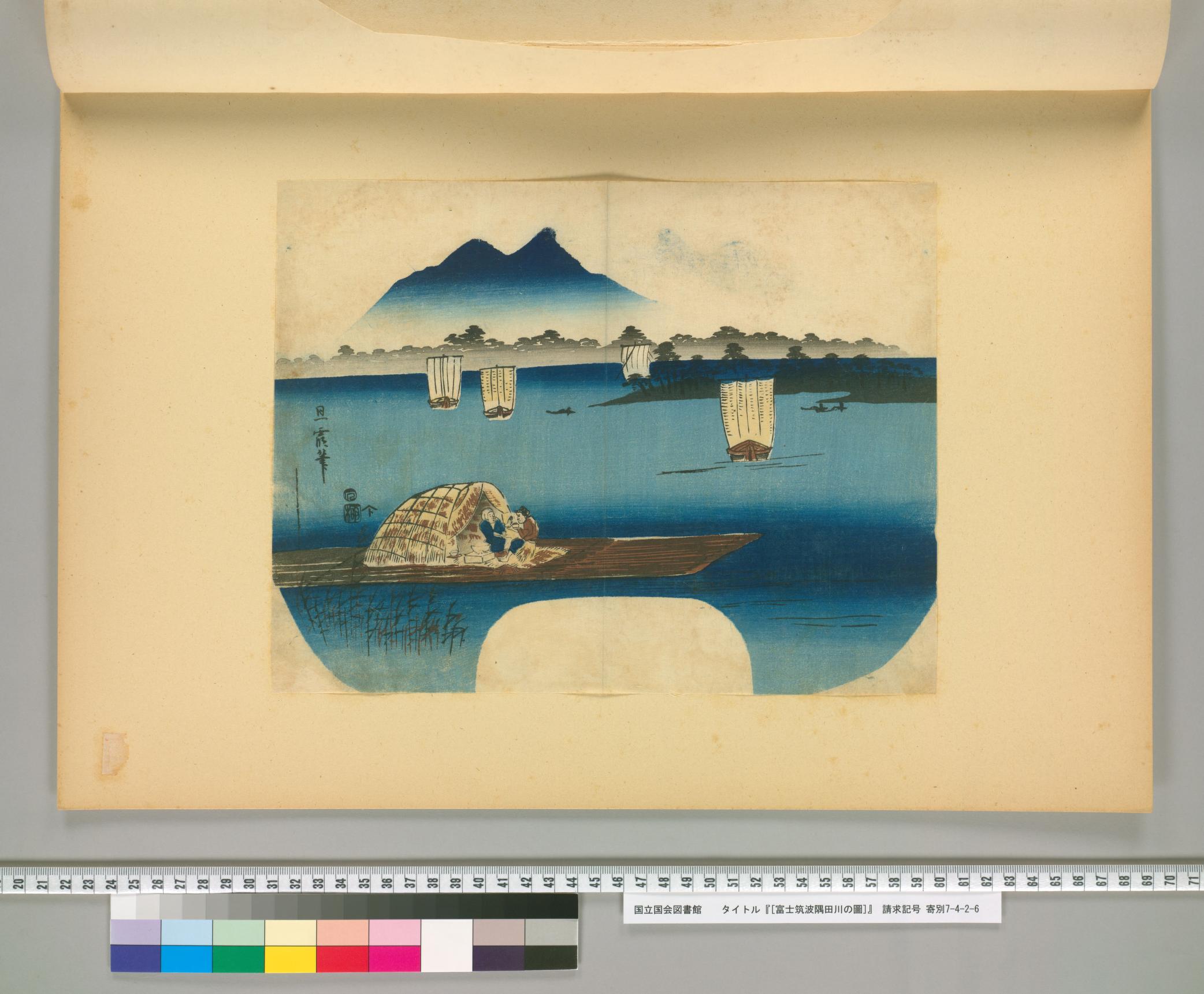
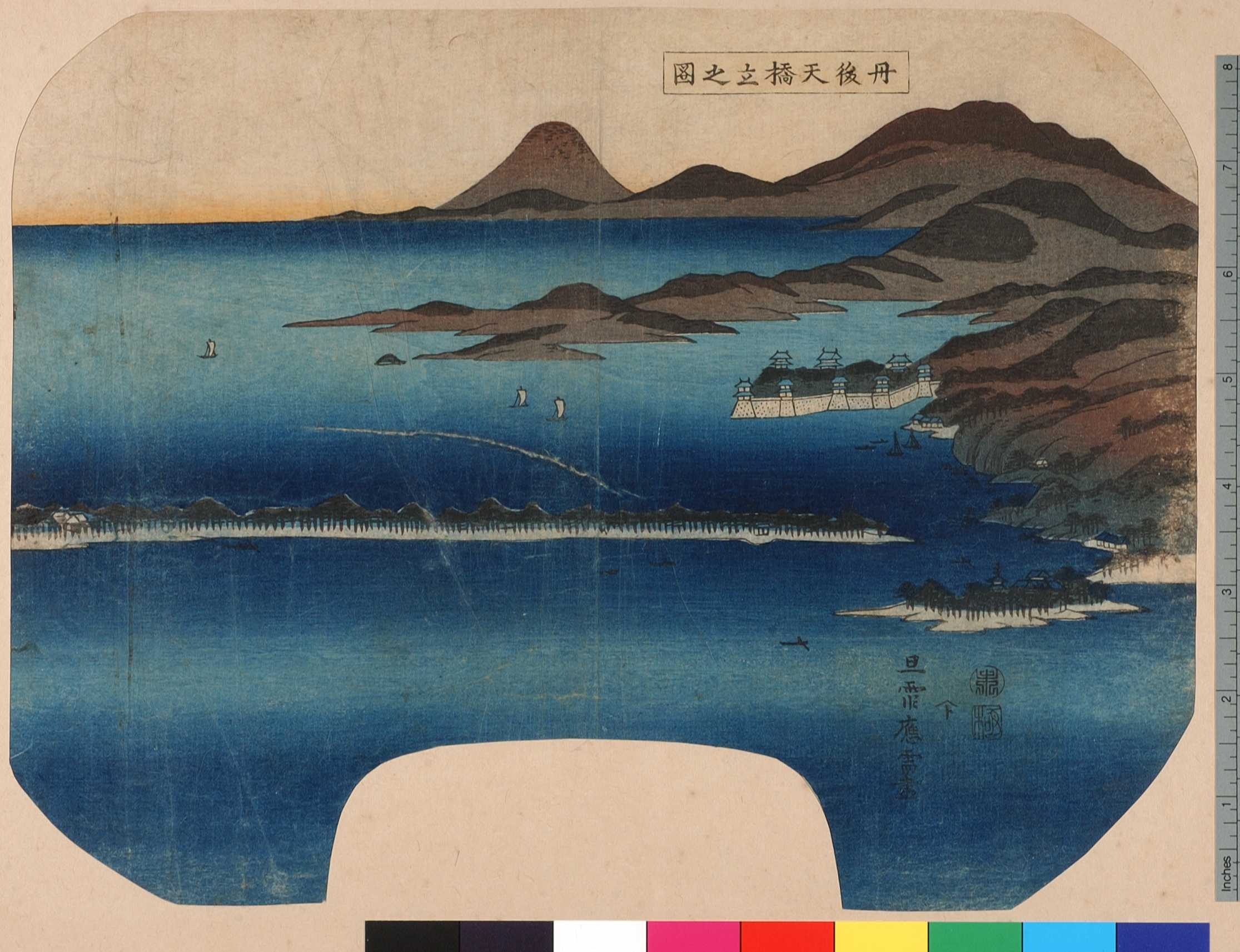 (3) RISD Museum 34.334:
(3) RISD Museum 34.334:
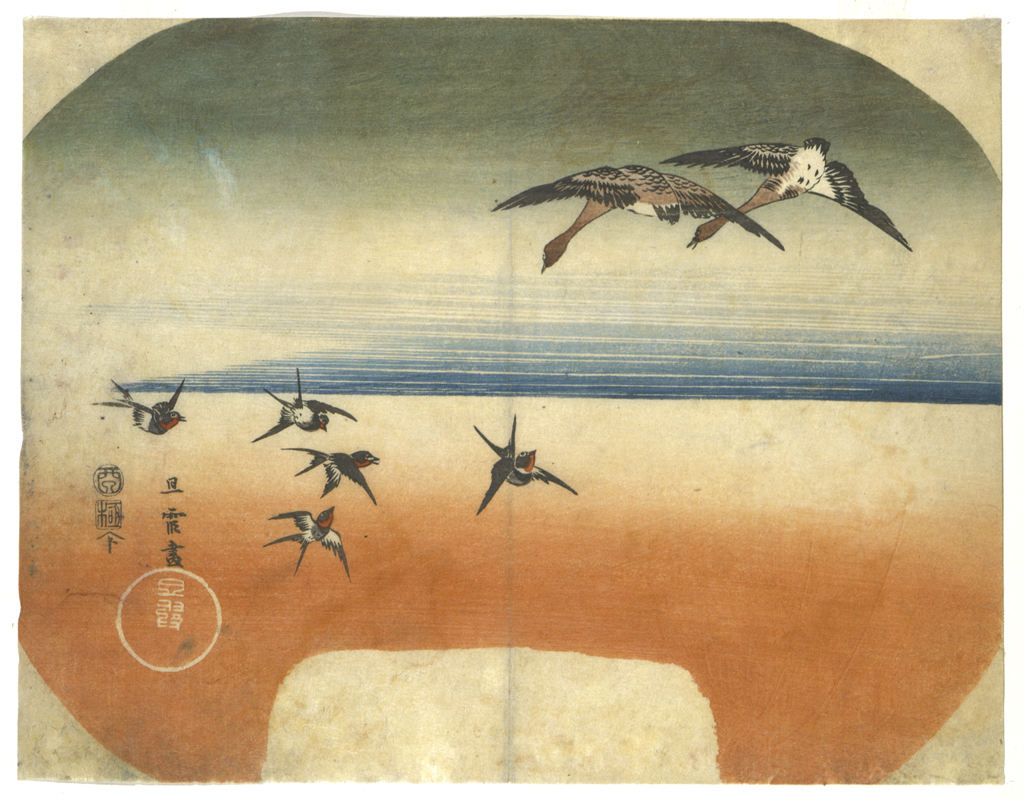
-
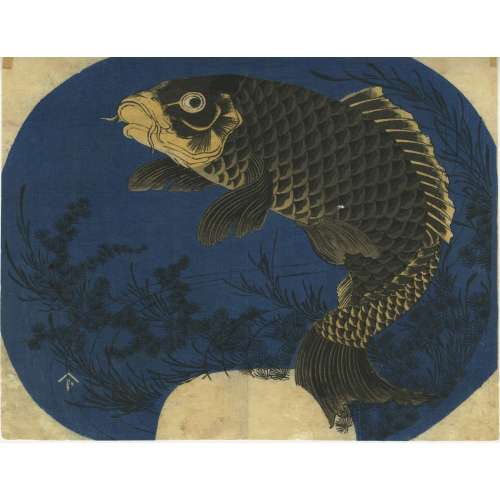 NEWAn uncut fan print depicting a carp (koi) swimming amid aquatic plants against a deep blue background. Artist: unknown/unsigned, possibly Katsushika Hokusai [葛飾 北斎] (Japanese, 1760 – 1849). Publisher: Enshūya Matabei [遠州屋又兵衛] (Japanese, fl. c. 1768 – 1881) Date: No date seal, no censor seal (privately printed?) Media: Fan print (uchiwa-e, 団扇絵), 224 x 290 mm. Similar subject:
NEWAn uncut fan print depicting a carp (koi) swimming amid aquatic plants against a deep blue background. Artist: unknown/unsigned, possibly Katsushika Hokusai [葛飾 北斎] (Japanese, 1760 – 1849). Publisher: Enshūya Matabei [遠州屋又兵衛] (Japanese, fl. c. 1768 – 1881) Date: No date seal, no censor seal (privately printed?) Media: Fan print (uchiwa-e, 団扇絵), 224 x 290 mm. Similar subject: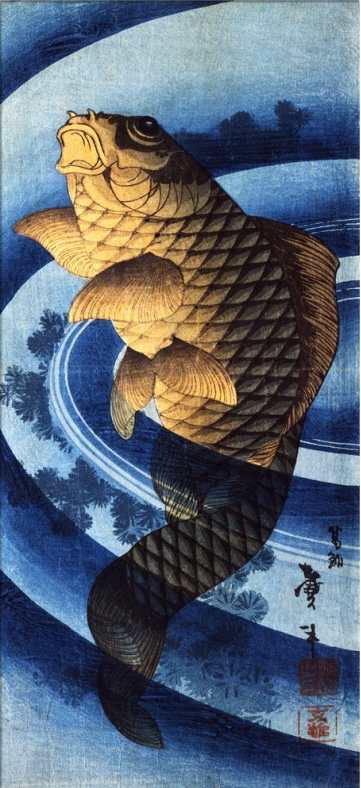
Katsushika TAITO II (fl. c. 1810-53)
-
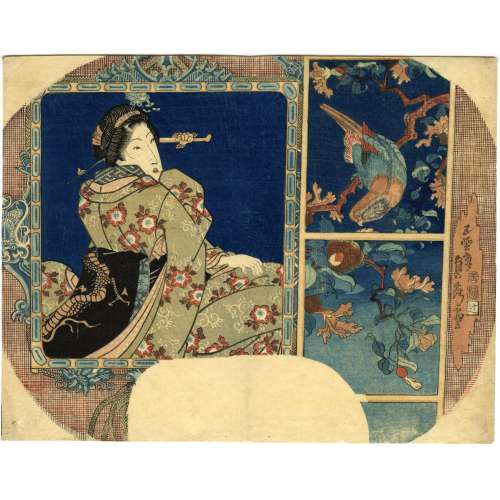 Artist: Utagawa Sadahide [歌川 貞秀], a.k.a. Gountei Sadahide [五雲亭 貞秀] (1807 – c. 1878/9). Publisher: Iseya Ichiemon [伊勢屋市右衛門] (Japanese, fl. c 1823 – 1864), seal name Kaku-Tsuji [角辻]. Signed: Gountei Sadahide ga [五雲亭貞秀画] Censor's seal: kiwame, date seal: Tenpō 3 (1832). Size: Uncut fan print (uchiwa-e); 218 x 282 mm. Portrait of a young woman dressed in a green kimono decorated with arabesque (karakusa) and flowers, her black obi adorned with a dragon, in a western-style frame, on a blue background; and a painting of a parrot on a pomegranate tree. A similar design was used by Sadahide in 1860, described in detail by Sebastian Izzard in his Japanese Prints of the Mid-Nineteenth Century: 1830–1865, September 20–October 24, 2006 exhibition: Picture of a Curio Shop in Yokohama: reverse painting on glass of a crimson parrot, coloured copperplate engraving of a mother and child (Yokohama urimono mise no zu: gyokuban abura-e, doban-e saishiki). Colour woodblock print: oban tate-e, 143/8 x 93/4 in. (36.5 x 24.8 cm.); Man-en I/3 (3/1860) Series: Picture of Goods for Sale in Yokohama (Yokohama urimono zue no uchi) Signature: Gountei Sadahide ga, double toshidama seal Publisher: Daikokuya Kinnosuke.
Artist: Utagawa Sadahide [歌川 貞秀], a.k.a. Gountei Sadahide [五雲亭 貞秀] (1807 – c. 1878/9). Publisher: Iseya Ichiemon [伊勢屋市右衛門] (Japanese, fl. c 1823 – 1864), seal name Kaku-Tsuji [角辻]. Signed: Gountei Sadahide ga [五雲亭貞秀画] Censor's seal: kiwame, date seal: Tenpō 3 (1832). Size: Uncut fan print (uchiwa-e); 218 x 282 mm. Portrait of a young woman dressed in a green kimono decorated with arabesque (karakusa) and flowers, her black obi adorned with a dragon, in a western-style frame, on a blue background; and a painting of a parrot on a pomegranate tree. A similar design was used by Sadahide in 1860, described in detail by Sebastian Izzard in his Japanese Prints of the Mid-Nineteenth Century: 1830–1865, September 20–October 24, 2006 exhibition: Picture of a Curio Shop in Yokohama: reverse painting on glass of a crimson parrot, coloured copperplate engraving of a mother and child (Yokohama urimono mise no zu: gyokuban abura-e, doban-e saishiki). Colour woodblock print: oban tate-e, 143/8 x 93/4 in. (36.5 x 24.8 cm.); Man-en I/3 (3/1860) Series: Picture of Goods for Sale in Yokohama (Yokohama urimono zue no uchi) Signature: Gountei Sadahide ga, double toshidama seal Publisher: Daikokuya Kinnosuke.
-
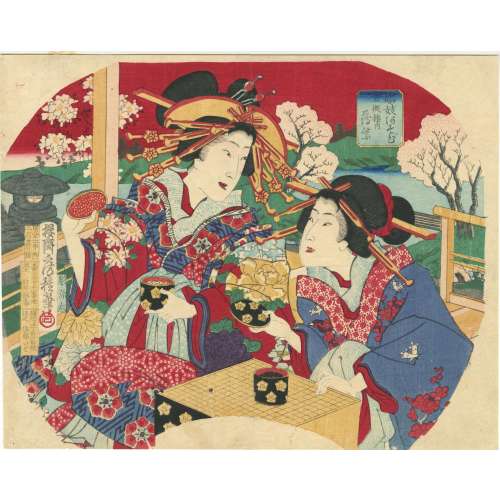 Artist: Utagawa Fusatane [歌川 房種] (Japanese, fl. 1854 – 1889), other names: Ippyosai; Isshosai; Murai Seima; Utagawa Seimas; Osai; Signed: Ōsai Fusatane Hitsu [桜斎房種筆] in a cartouche, with a round stamp. Block carver: Watanabe Yatarō (Japanese, 1850 – 1913); seal [彫弥太] – Hori Yata (Friese 2009b: 117). Publisher [板元] (Hammoto): Satō Ise [佐藤いせ], address: Horiechō, Nichōme, ichi-banchi [堀江町二丁目一番地] Publication date [御届] (otodoke): Meiji 10th year, 3rd month, 22nd day (1877). Artist [画工] (Gakō): Murai Seima [村井 静馬], address: Honjo-Sotodechō, 18 [本所外手丁十八番地]. Uncut fan print (uchiwa-e), 236 x 297 mm, depicting two harlots or courtesans playing [娼妓あそび] (shōgi asobi) go game in the famous Kinpeiro [金瓶楼内] brothel in New Yoshiwara in Tokyo. In the courtesan's name, the second character seems to be 紫 (Murasaki); the first character is unclear, so we do not know her name yet.
Artist: Utagawa Fusatane [歌川 房種] (Japanese, fl. 1854 – 1889), other names: Ippyosai; Isshosai; Murai Seima; Utagawa Seimas; Osai; Signed: Ōsai Fusatane Hitsu [桜斎房種筆] in a cartouche, with a round stamp. Block carver: Watanabe Yatarō (Japanese, 1850 – 1913); seal [彫弥太] – Hori Yata (Friese 2009b: 117). Publisher [板元] (Hammoto): Satō Ise [佐藤いせ], address: Horiechō, Nichōme, ichi-banchi [堀江町二丁目一番地] Publication date [御届] (otodoke): Meiji 10th year, 3rd month, 22nd day (1877). Artist [画工] (Gakō): Murai Seima [村井 静馬], address: Honjo-Sotodechō, 18 [本所外手丁十八番地]. Uncut fan print (uchiwa-e), 236 x 297 mm, depicting two harlots or courtesans playing [娼妓あそび] (shōgi asobi) go game in the famous Kinpeiro [金瓶楼内] brothel in New Yoshiwara in Tokyo. In the courtesan's name, the second character seems to be 紫 (Murasaki); the first character is unclear, so we do not know her name yet. -
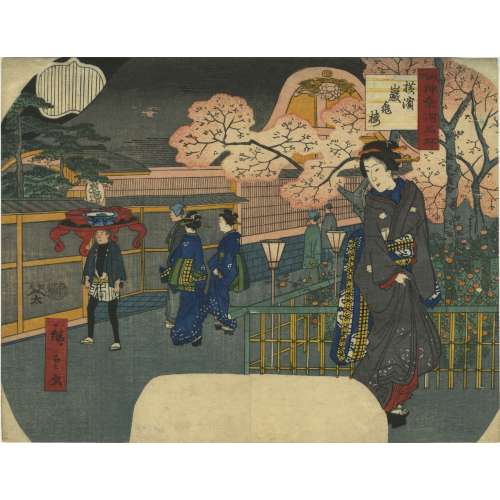 NEWIn red cartouche: Famous places in Bushū and Kanagawa (Bushū Kanagawa meisho) [武州神奈河名昕] In yellow striped square: Gankirō in Yokohama (Yokohama Gankirō) [横濱巌亀楼] / new spelling 横浜岩亀楼. The three kanji [岩亀楼] (Gankirō) are also visible on the sign or lantern above the food tray, carried on the head by a man on the left. Gankirō – the largest 'tea house' (brothel) for foreigners in the Miyozaki pleasure quarters, similar to those in Yoshiwara, in Edo. Artist: Utagawa Hiroshige II [二代目 歌川広重] (Japanese, 1826 – 1869) – a son-in-law of Andō Hiroshige. Signature: Hiroshige ga [廣重画] Dimensions: Aiban yoko-e uchiwa-e, 223 x 289 mm. Combined date/censor seal: monkey (saru - 申) and kiwame (極), 1860. Publisher: Yama-Ta; seal: [板元, 太] – Hanmoto, Ta; Marks 19-044 | U421b: An unknown publisher in Edo, fl. c. 1815-61. Another Hiroshige II's print with the same subject and even the same characters, but in 3rd month, 1859: Entrance to the Gankirō Tea House in the Miyozaki District, Yokohama, Bushu (Bushu Yokohama Gankirō) [諸国名所百景 武州横浜岩亀楼]. Utagawa Yoshikazu's [歌川芳員] depiction of the place in c. 1861 from the inside:[Thanks to Horst Graebner].
NEWIn red cartouche: Famous places in Bushū and Kanagawa (Bushū Kanagawa meisho) [武州神奈河名昕] In yellow striped square: Gankirō in Yokohama (Yokohama Gankirō) [横濱巌亀楼] / new spelling 横浜岩亀楼. The three kanji [岩亀楼] (Gankirō) are also visible on the sign or lantern above the food tray, carried on the head by a man on the left. Gankirō – the largest 'tea house' (brothel) for foreigners in the Miyozaki pleasure quarters, similar to those in Yoshiwara, in Edo. Artist: Utagawa Hiroshige II [二代目 歌川広重] (Japanese, 1826 – 1869) – a son-in-law of Andō Hiroshige. Signature: Hiroshige ga [廣重画] Dimensions: Aiban yoko-e uchiwa-e, 223 x 289 mm. Combined date/censor seal: monkey (saru - 申) and kiwame (極), 1860. Publisher: Yama-Ta; seal: [板元, 太] – Hanmoto, Ta; Marks 19-044 | U421b: An unknown publisher in Edo, fl. c. 1815-61. Another Hiroshige II's print with the same subject and even the same characters, but in 3rd month, 1859: Entrance to the Gankirō Tea House in the Miyozaki District, Yokohama, Bushu (Bushu Yokohama Gankirō) [諸国名所百景 武州横浜岩亀楼]. Utagawa Yoshikazu's [歌川芳員] depiction of the place in c. 1861 from the inside:[Thanks to Horst Graebner].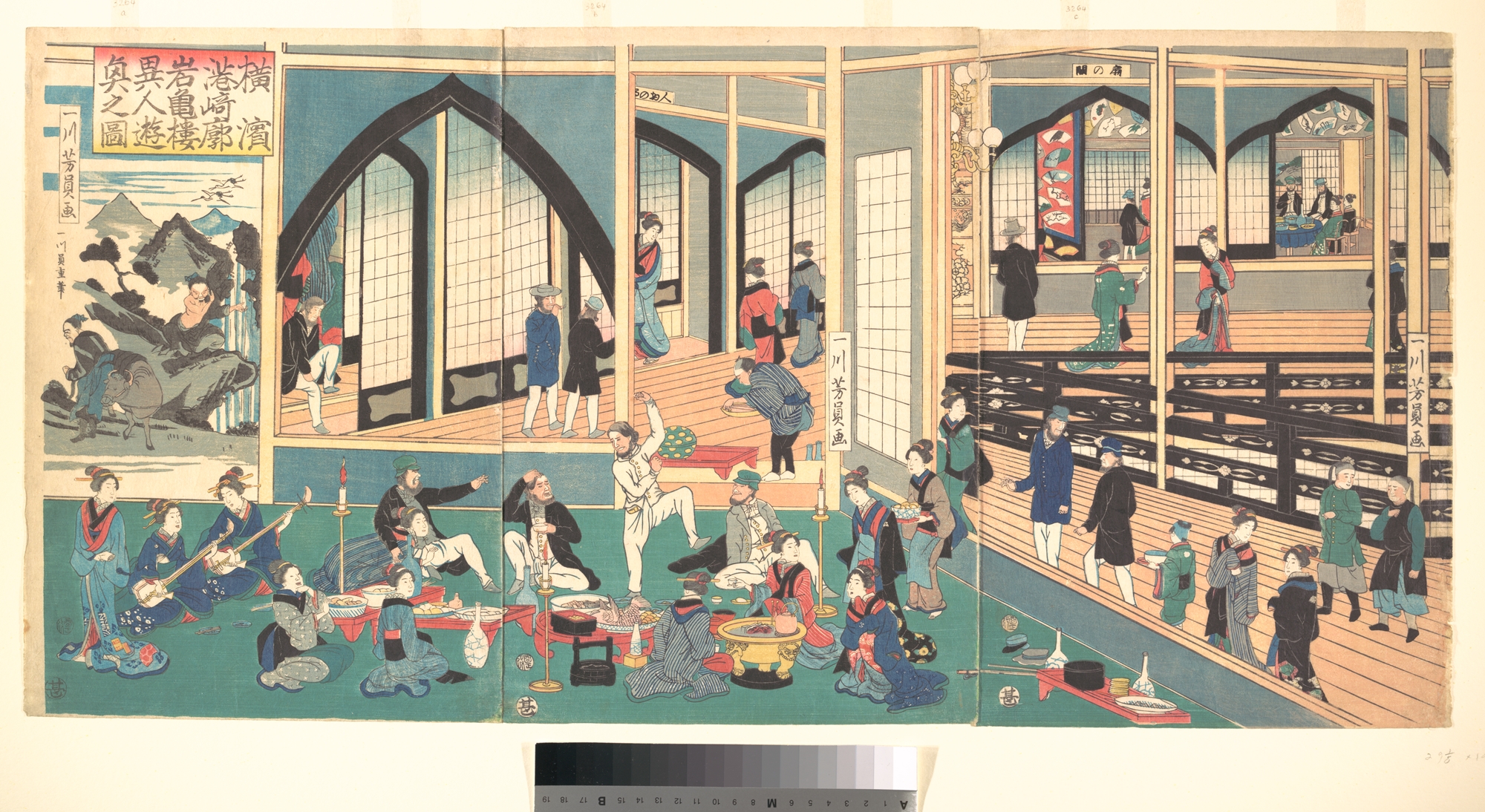
Foreigners Enjoying Themselves in the Gankirō. MET JP3264.
-
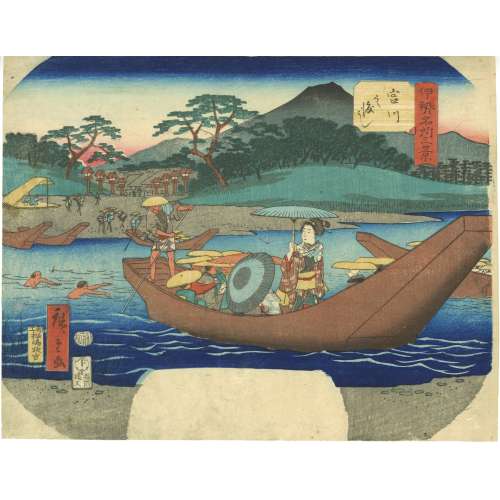 Artist: Utagawa Hiroshige II (二代目 歌川広重] (Japanese, 1826 – 1869). Signed: Hiroshige ga. Publisher: Enshūya Matabei [遠州屋又兵衛] (Japanese, fl. c. 1768 – 1881); (Enmata [遠又]), seal 22-009 (Marks). Block carver: Matsushima Masakichi (Japanese, fl. c. 1847-65); seal: [松嶋彫政] – Hori Masa (Frieze, 2009: 142). Combined date seal and kiwame censor seal: Bunkyū 2 (1862). Media: Fan print (uchiwa-e, 団扇絵), 230 x 298 mm Series: Three Famous Views in Ise [伊勢名所三景] (Ise meisho sankei).
Artist: Utagawa Hiroshige II (二代目 歌川広重] (Japanese, 1826 – 1869). Signed: Hiroshige ga. Publisher: Enshūya Matabei [遠州屋又兵衛] (Japanese, fl. c. 1768 – 1881); (Enmata [遠又]), seal 22-009 (Marks). Block carver: Matsushima Masakichi (Japanese, fl. c. 1847-65); seal: [松嶋彫政] – Hori Masa (Frieze, 2009: 142). Combined date seal and kiwame censor seal: Bunkyū 2 (1862). Media: Fan print (uchiwa-e, 団扇絵), 230 x 298 mm Series: Three Famous Views in Ise [伊勢名所三景] (Ise meisho sankei). -
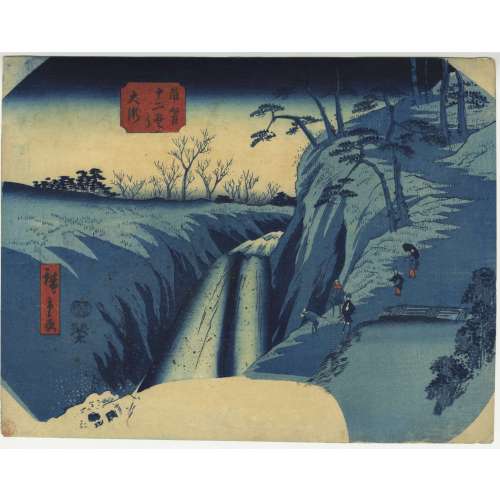 NEWTitle: The Great Waterfall at the Twelve Shrines of Tsunohazu (Tsunohazu juniso otaki) [角筈十二社大滝] from an untitled set of views of famous places in Edo. Artist: Utagawa Hiroshige II [二代目 歌川広重] (Japanese, 1826 – 1869) – a son-in-law of Andō Hiroshige. Signature: Hiroshige ga [廣重画] Dimensions: Aiban yoko-e uchiwa-e, 226 x 291 mm. Combined date/censor seal: tori, 酉 / kiwame 極 – 1861 (Man'en 2 / Bunkyū 1 from 19/II). Publisher: Yama-Ta; seal: [板元, 太] – Hanmoto, Ta; Marks 19-044 | U421b: An unknown publisher in Edo, fl. c. 1815-61. Provenance: Collection of Maroni, Albert (French, 1852 – 1923), red stamp in the bottom-left corner. Reference: [LIB-3429.2025] Christie’s, New York: Japanese Art, Thursday 24 April 1997 / Sales Catalogue; lot № 312.
NEWTitle: The Great Waterfall at the Twelve Shrines of Tsunohazu (Tsunohazu juniso otaki) [角筈十二社大滝] from an untitled set of views of famous places in Edo. Artist: Utagawa Hiroshige II [二代目 歌川広重] (Japanese, 1826 – 1869) – a son-in-law of Andō Hiroshige. Signature: Hiroshige ga [廣重画] Dimensions: Aiban yoko-e uchiwa-e, 226 x 291 mm. Combined date/censor seal: tori, 酉 / kiwame 極 – 1861 (Man'en 2 / Bunkyū 1 from 19/II). Publisher: Yama-Ta; seal: [板元, 太] – Hanmoto, Ta; Marks 19-044 | U421b: An unknown publisher in Edo, fl. c. 1815-61. Provenance: Collection of Maroni, Albert (French, 1852 – 1923), red stamp in the bottom-left corner. Reference: [LIB-3429.2025] Christie’s, New York: Japanese Art, Thursday 24 April 1997 / Sales Catalogue; lot № 312.An aizuri-e (blue print) on a popular topic, many times depicted by Andō Hiroshige and Hiroshige II, including the below print by the latter No. 45, the Twelve Kumano Shrines at Tsunohazu (Tsunohazu Kumano jûnisha), from the series Forty-Eight Famous Views of Edo (Edo meisho yonjûhakkei)「江戸名所四十八景 四十五 角筈熊野十二社」
-
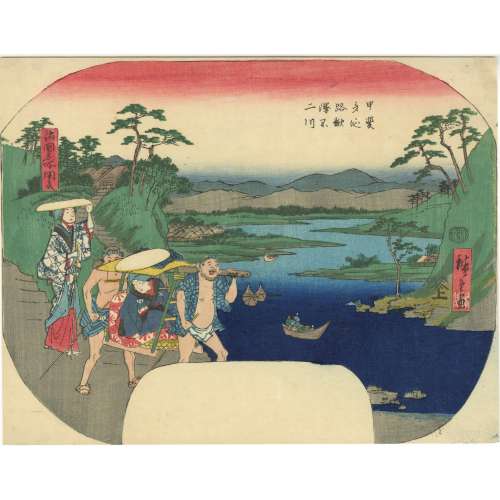 Artist: Utagawa Hiroshige II (二代目 歌川広重] (Japanese, 1826 – 1869). Signed: Hiroshige ga. Publisher: Iseya Sōemon [伊勢屋惣右衛門] (Japanese, c. 1776 – 1862); seal: Hanmoto, Ue [板元 上] (Marks 19-047 | 156d). Combined date seal and kiwame censor seal: Bunkyū 2 (1862) Media: Fan print (uchiwa-e, 団扇絵), 230 x 296 mm.
Artist: Utagawa Hiroshige II (二代目 歌川広重] (Japanese, 1826 – 1869). Signed: Hiroshige ga. Publisher: Iseya Sōemon [伊勢屋惣右衛門] (Japanese, c. 1776 – 1862); seal: Hanmoto, Ue [板元 上] (Marks 19-047 | 156d). Combined date seal and kiwame censor seal: Bunkyū 2 (1862) Media: Fan print (uchiwa-e, 団扇絵), 230 x 296 mm. -
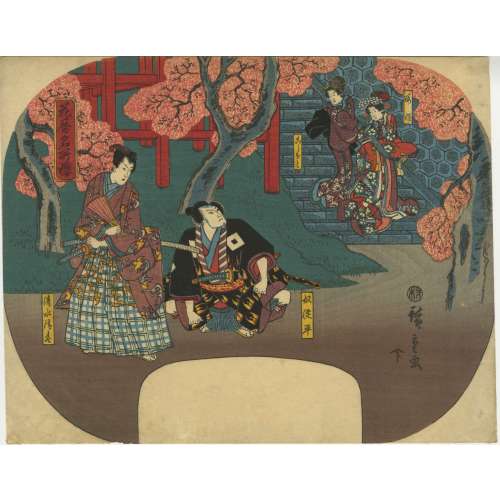 NEWTitle: Flower calendar for the famous cherry blossoms (Hana goyomi meisho sakura) [花暦名所櫻]. A scene from an imaginary (mitate) kabuki play. Names of the characters (left to right): Kiyomizu/Shimizu Seigen [清水清玄]; Yakko (footman) Yodohei [奴淀平]; koshimoto (court lady) [こしもと]; Sakura hime (princess) [桜姫]. The same characters appear in a few real kabuki plays. Artist: Utagawa Hiroshige [歌川 広重] a.k.a. Andō Hiroshige [安藤 広重] (Japanese, 1797 – 1858) Signature: Hiroshige ga [廣重画] Dimensions: Aiban yoko-e uchiwa-e, 232 x 295 mm. Censor seal: "Mura" [村] for Murata Sahei [村田佐兵衛], used from VI/1842 to V/1846 (Tenpō 13 – Kōka 3). Publisher: Enshūya Matabei [遠州屋又兵衛] (Enterprise, active c. 1768 – 1881); seal: "To" (ト) (Marks 01-031 | 057a). [Thanks to Horst Graebner].
NEWTitle: Flower calendar for the famous cherry blossoms (Hana goyomi meisho sakura) [花暦名所櫻]. A scene from an imaginary (mitate) kabuki play. Names of the characters (left to right): Kiyomizu/Shimizu Seigen [清水清玄]; Yakko (footman) Yodohei [奴淀平]; koshimoto (court lady) [こしもと]; Sakura hime (princess) [桜姫]. The same characters appear in a few real kabuki plays. Artist: Utagawa Hiroshige [歌川 広重] a.k.a. Andō Hiroshige [安藤 広重] (Japanese, 1797 – 1858) Signature: Hiroshige ga [廣重画] Dimensions: Aiban yoko-e uchiwa-e, 232 x 295 mm. Censor seal: "Mura" [村] for Murata Sahei [村田佐兵衛], used from VI/1842 to V/1846 (Tenpō 13 – Kōka 3). Publisher: Enshūya Matabei [遠州屋又兵衛] (Enterprise, active c. 1768 – 1881); seal: "To" (ト) (Marks 01-031 | 057a). [Thanks to Horst Graebner]. -
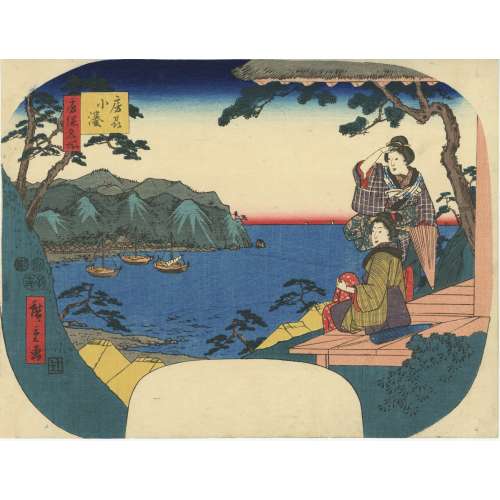 Kominato in Awa province (Bōshū Kominato) [房州小淡] – one of five fan prints in the series Famous places in the Bōsō peninsula (Bōsō meisho) [房粉名所], devoted to the trip undertaken by Hiroshige in 1852 to Bōsō peninsula (present-day Chiba prefecture). “Two fashionably dressed women beside the veranda of a wayside inn gaze out over Uchiura Bay toward the Tanjō Temple on the far shore as a boat sets out to the sea from the fishing hamlet of Kominato. …Hiroshige’s viewpoint is from the lower slopes of Mount Kiyosumi” (Izzard, 2020). Reference: (1) [LIB-2398.2020] Sebastian Izzard. Important Japanese Prints 1830–1860 March 14–20, 2020 exhibition, №. 52. (2) Christophe Marquet. Hiroshige: Les éventails d'Edo / Estampes de la collection Georges Leskowicz. — Paris: In fine, 2022, № 30, p. 94. Artist: Utagawa Hiroshige [歌川 広重] a.k.a. Andō Hiroshige [安藤 広重] (Japanese, 1797 – 1858). Signed: Hiroshige ga [広重 画] in a red cartouche. Publisher: Iseya Ichiemon 伊勢屋市右衛門] (Japanese, c. 1823 – 1864); seal Kaku-Tsuji 角辻 / Marks 16-023|143a. Date seal and double nanushi censor seal: Mera & Watanabe [米良 & 波邊]; Kaei 5, 12th month of the year of the Rat (1852). Dimensions: Fan print (Aiban yoko-e uchiwa-e); 225 x 292 mm.
Kominato in Awa province (Bōshū Kominato) [房州小淡] – one of five fan prints in the series Famous places in the Bōsō peninsula (Bōsō meisho) [房粉名所], devoted to the trip undertaken by Hiroshige in 1852 to Bōsō peninsula (present-day Chiba prefecture). “Two fashionably dressed women beside the veranda of a wayside inn gaze out over Uchiura Bay toward the Tanjō Temple on the far shore as a boat sets out to the sea from the fishing hamlet of Kominato. …Hiroshige’s viewpoint is from the lower slopes of Mount Kiyosumi” (Izzard, 2020). Reference: (1) [LIB-2398.2020] Sebastian Izzard. Important Japanese Prints 1830–1860 March 14–20, 2020 exhibition, №. 52. (2) Christophe Marquet. Hiroshige: Les éventails d'Edo / Estampes de la collection Georges Leskowicz. — Paris: In fine, 2022, № 30, p. 94. Artist: Utagawa Hiroshige [歌川 広重] a.k.a. Andō Hiroshige [安藤 広重] (Japanese, 1797 – 1858). Signed: Hiroshige ga [広重 画] in a red cartouche. Publisher: Iseya Ichiemon 伊勢屋市右衛門] (Japanese, c. 1823 – 1864); seal Kaku-Tsuji 角辻 / Marks 16-023|143a. Date seal and double nanushi censor seal: Mera & Watanabe [米良 & 波邊]; Kaei 5, 12th month of the year of the Rat (1852). Dimensions: Fan print (Aiban yoko-e uchiwa-e); 225 x 292 mm. -
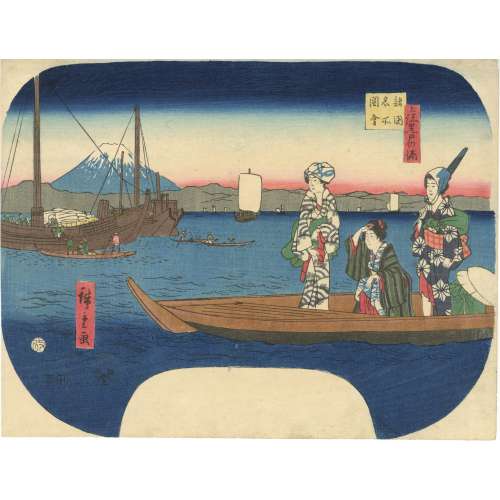 The Bay of Kuroto in Kazusa province [Kazusa Kuroto no ura] – an uncut fan print showing "Three women, wearing stylish cotton summer robes are shown in a skiff, admiring the view of Mount Fuji while looking back at the other passengers being helped into small boats". From the series: Views of famous places in the provinces [Shokoku meisho zue]. Ref: Sebastian Izzard. Important Japanese Prints 1830–1860 March 14–20, 2020 exhibition [LIB-2398.2020], №. 53. Not in Faulkner's Hiroshige Fan Prints, however, there are three other prints from the series, under № 95, 96 and 97 on p. 95. Artist: Utagawa Hiroshige [歌川 広重] a.k.a. Andō Hiroshige [安藤 広重] (Japanese, 1797 – 1858). Publisher: Iseya Sōemon [伊勢屋惣右衛門] (Japanese, c. 1776 – 1862). Date seal: 2/1855 Signed: Hiroshige ga. Censor's seal: aratame (certified) and date. Publisher's seal: Iseya Sōemon. Size: Aiban yoko-e uchiwa-e; 22.9 x 29.8 cm
The Bay of Kuroto in Kazusa province [Kazusa Kuroto no ura] – an uncut fan print showing "Three women, wearing stylish cotton summer robes are shown in a skiff, admiring the view of Mount Fuji while looking back at the other passengers being helped into small boats". From the series: Views of famous places in the provinces [Shokoku meisho zue]. Ref: Sebastian Izzard. Important Japanese Prints 1830–1860 March 14–20, 2020 exhibition [LIB-2398.2020], №. 53. Not in Faulkner's Hiroshige Fan Prints, however, there are three other prints from the series, under № 95, 96 and 97 on p. 95. Artist: Utagawa Hiroshige [歌川 広重] a.k.a. Andō Hiroshige [安藤 広重] (Japanese, 1797 – 1858). Publisher: Iseya Sōemon [伊勢屋惣右衛門] (Japanese, c. 1776 – 1862). Date seal: 2/1855 Signed: Hiroshige ga. Censor's seal: aratame (certified) and date. Publisher's seal: Iseya Sōemon. Size: Aiban yoko-e uchiwa-e; 22.9 x 29.8 cm -
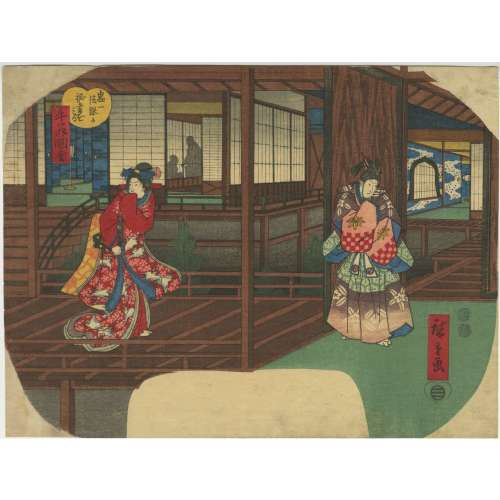 NEWTitle: The Secret Meeting between Ushiwakamaru and the Daughter of Kiichi Hōgen (Kiichi Hōgen ga hisho o miro) [鬼一法眼が秘書をみる] Series: Scenes from the life of Ushiwaka (Ushiwaka zue) [牛若図会] Artist: Utagawa Hiroshige [歌川 広重] a.k.a. Andō Hiroshige [安藤 広重] (Japanese, 1797 – 1858) Signature: Hiroshige ga [廣重画] Dimensions: Aiban yoko-e uchiwa-e, 226 x 303 mm. Censor seal: Hama & Magome [濱 / 馬込]: 1/1849 – 2/1852 (Kaei 2-5) Publisher: Ibaya Senzaburō [伊場屋仙三郎] (Japanese, fl. C. 1845 – 1847), seal: San [三] (Marks 11-001 | 127c). According to Rupert Faulkner (2001), another copy of this fan print is housed at Ōta Memorial Museum (ŌMM 1998, № 258). There are four other known prints from this series: (1) The Meeting at Yahagi: The Beginnings of the Jorurijunidan Story (Yahagi no Shuku Jorurijunidan no Hajime); (2) Ushiwakamaru practising swordsmanship at Sojogatani (ŌMM 1998, no.256); (3) Ushiwakamaru's encounter with Benkei on Gojo Bridge (Matsuki 1924, no.93); and (4) Ise no Saburo swearing an oath of loyalty to Ushiwakamaru (Kanagawa Prefectural Museum of Cultural History). Kiichi Hōgen [鬼一法眼] is a legendary monk and warrior who trained Ushiwakamaru (young Minamoto no Yoshitsune) in swordsmanship, tactics, and magic.Another print (Ushiwakamaru's encounter with Benkei on Gojo Bridge) from this series is in the collection of the Art Institute of Chicago under the title Killing One Thousand People at Gojo Bridge (Gojo no hashi sennin kiri).
NEWTitle: The Secret Meeting between Ushiwakamaru and the Daughter of Kiichi Hōgen (Kiichi Hōgen ga hisho o miro) [鬼一法眼が秘書をみる] Series: Scenes from the life of Ushiwaka (Ushiwaka zue) [牛若図会] Artist: Utagawa Hiroshige [歌川 広重] a.k.a. Andō Hiroshige [安藤 広重] (Japanese, 1797 – 1858) Signature: Hiroshige ga [廣重画] Dimensions: Aiban yoko-e uchiwa-e, 226 x 303 mm. Censor seal: Hama & Magome [濱 / 馬込]: 1/1849 – 2/1852 (Kaei 2-5) Publisher: Ibaya Senzaburō [伊場屋仙三郎] (Japanese, fl. C. 1845 – 1847), seal: San [三] (Marks 11-001 | 127c). According to Rupert Faulkner (2001), another copy of this fan print is housed at Ōta Memorial Museum (ŌMM 1998, № 258). There are four other known prints from this series: (1) The Meeting at Yahagi: The Beginnings of the Jorurijunidan Story (Yahagi no Shuku Jorurijunidan no Hajime); (2) Ushiwakamaru practising swordsmanship at Sojogatani (ŌMM 1998, no.256); (3) Ushiwakamaru's encounter with Benkei on Gojo Bridge (Matsuki 1924, no.93); and (4) Ise no Saburo swearing an oath of loyalty to Ushiwakamaru (Kanagawa Prefectural Museum of Cultural History). Kiichi Hōgen [鬼一法眼] is a legendary monk and warrior who trained Ushiwakamaru (young Minamoto no Yoshitsune) in swordsmanship, tactics, and magic.Another print (Ushiwakamaru's encounter with Benkei on Gojo Bridge) from this series is in the collection of the Art Institute of Chicago under the title Killing One Thousand People at Gojo Bridge (Gojo no hashi sennin kiri).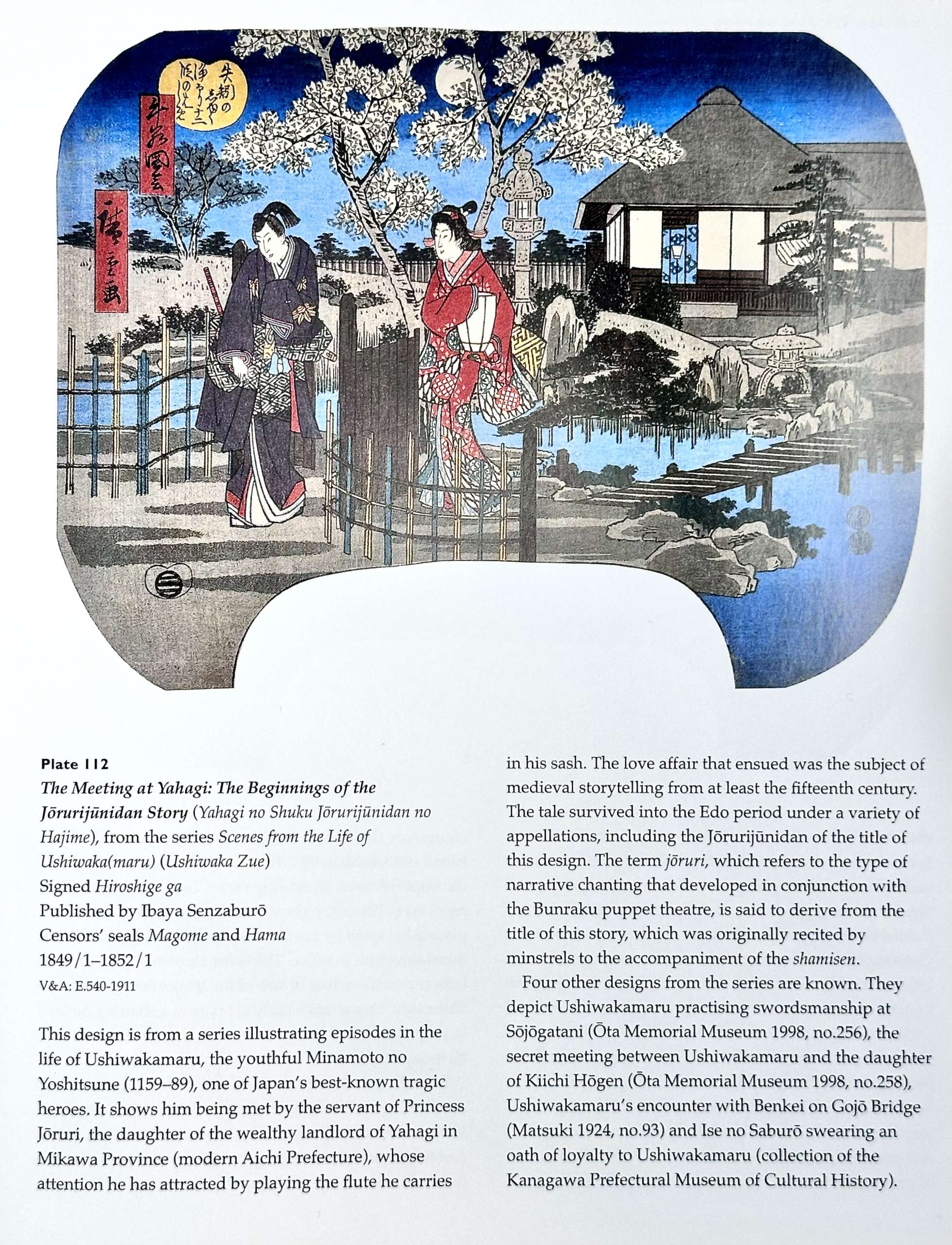
Rupert Faulkner (2001)
Reference: (1) Rupert Faulkner. Hiroshige Fan Prints / Victoria and Albert Museum, Far Eastern Series. — London: V&A Publications; NY: Harry N. Abrams, Inc., 2001. (2) Christophe Marquet. Hiroshige: Les éventails d'Edo / Estampes de la collection Georges Leskowicz. — Paris: In fine, 2022. [Thanks to Horst Graebner].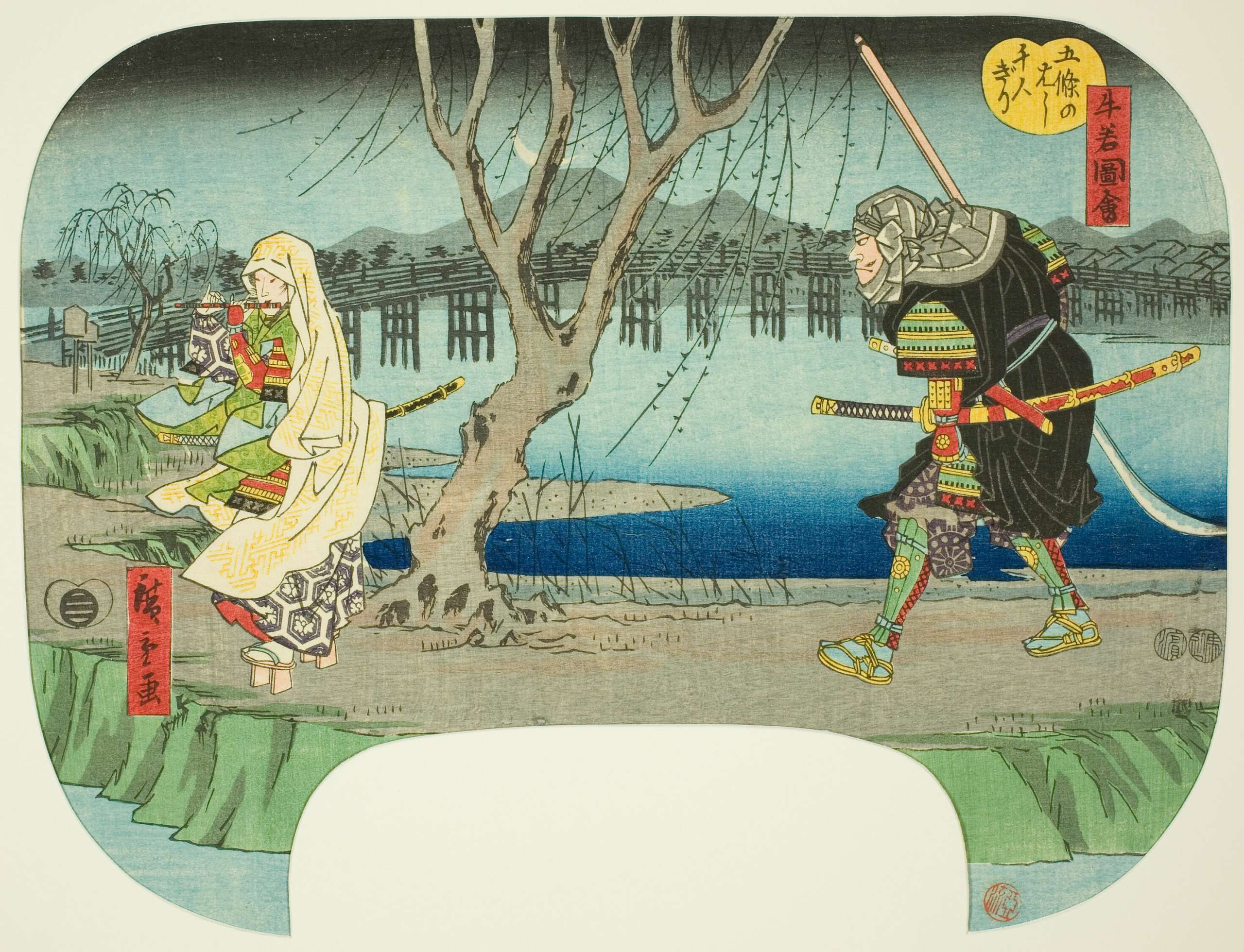
AIC Reference Number 1925.3802
-
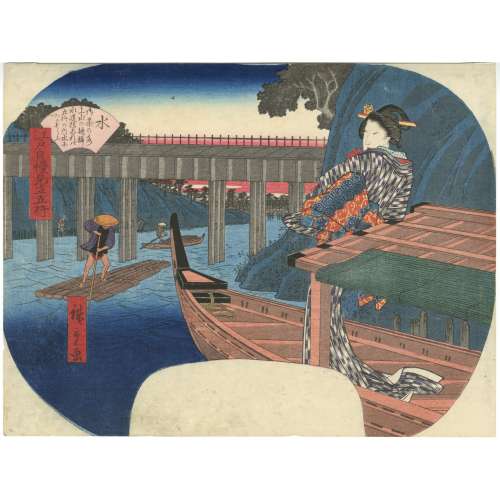 One of five fan prints from the series The Pride of Edo Compared to the Five Elements [Edo jiman mitate gogyo]. Artist: Utagawa Hiroshige [歌川 広重] a.k.a. Andō Hiroshige [安藤 広重] (Japanese, 1797 – 1858). Publisher: Ibaya Kyubei [伊場屋 久兵衛] (Japanese, fl. 1804 – 1851). Signed: Hiroshige ga Censor’s seal: Muramatsu Publisher's seal: Kinseido (Ibaya Kyubei) The text in the fan-shaped cartouche reads: "Water: The Square Aqueduct that Crosses by Suido Bridge Suggests the comparison of Ochanomizu to Water [Mizu: Ochanomizu josui no himasu Suidobashi areba gogyo no uchi mizu ni nazorau]". Ref: Rupert Faulkner. Hiroshige Fan Prints. Victoria and Albert Museum. Far Eastern Series. Hardcover - Harry N. Abrams, Inc. - 2001 [LIB-1344.2017] № 22, p. 51. Comment from Sebastian Izzard: This series of five prints features full-length figures of women set in landscapes around Edo compared to the five natural elements: fire, water, earth, wood, and metal. A preparatory drawing for the “Wood” image, featuring a woman crossing a bridge in the snow at the timber yards of Fukagawa, is owned by the Kanagawa Prefectural Museum of History in Yokohama. A preparatory drawing also exists for the “Earth” image, which portrays a woman seated on a bench at Nakabashi, for which no print is extant. Two examples of the “Fire” subject exist; it pictures a woman holding a lantern at night on an embankment, while in the river behind her, a fishermen employ fire to trap their catch. The “Water” subject depicts a woman on a pleasure boat on the Ocha-no-mizu waterway. One example of the “Metal” subject is known, included in Izzard's Important Japanese Prints 1830–1860 March 14–20, 2020 exhibition [LIB-2398.2020], under №. 51.
One of five fan prints from the series The Pride of Edo Compared to the Five Elements [Edo jiman mitate gogyo]. Artist: Utagawa Hiroshige [歌川 広重] a.k.a. Andō Hiroshige [安藤 広重] (Japanese, 1797 – 1858). Publisher: Ibaya Kyubei [伊場屋 久兵衛] (Japanese, fl. 1804 – 1851). Signed: Hiroshige ga Censor’s seal: Muramatsu Publisher's seal: Kinseido (Ibaya Kyubei) The text in the fan-shaped cartouche reads: "Water: The Square Aqueduct that Crosses by Suido Bridge Suggests the comparison of Ochanomizu to Water [Mizu: Ochanomizu josui no himasu Suidobashi areba gogyo no uchi mizu ni nazorau]". Ref: Rupert Faulkner. Hiroshige Fan Prints. Victoria and Albert Museum. Far Eastern Series. Hardcover - Harry N. Abrams, Inc. - 2001 [LIB-1344.2017] № 22, p. 51. Comment from Sebastian Izzard: This series of five prints features full-length figures of women set in landscapes around Edo compared to the five natural elements: fire, water, earth, wood, and metal. A preparatory drawing for the “Wood” image, featuring a woman crossing a bridge in the snow at the timber yards of Fukagawa, is owned by the Kanagawa Prefectural Museum of History in Yokohama. A preparatory drawing also exists for the “Earth” image, which portrays a woman seated on a bench at Nakabashi, for which no print is extant. Two examples of the “Fire” subject exist; it pictures a woman holding a lantern at night on an embankment, while in the river behind her, a fishermen employ fire to trap their catch. The “Water” subject depicts a woman on a pleasure boat on the Ocha-no-mizu waterway. One example of the “Metal” subject is known, included in Izzard's Important Japanese Prints 1830–1860 March 14–20, 2020 exhibition [LIB-2398.2020], under №. 51.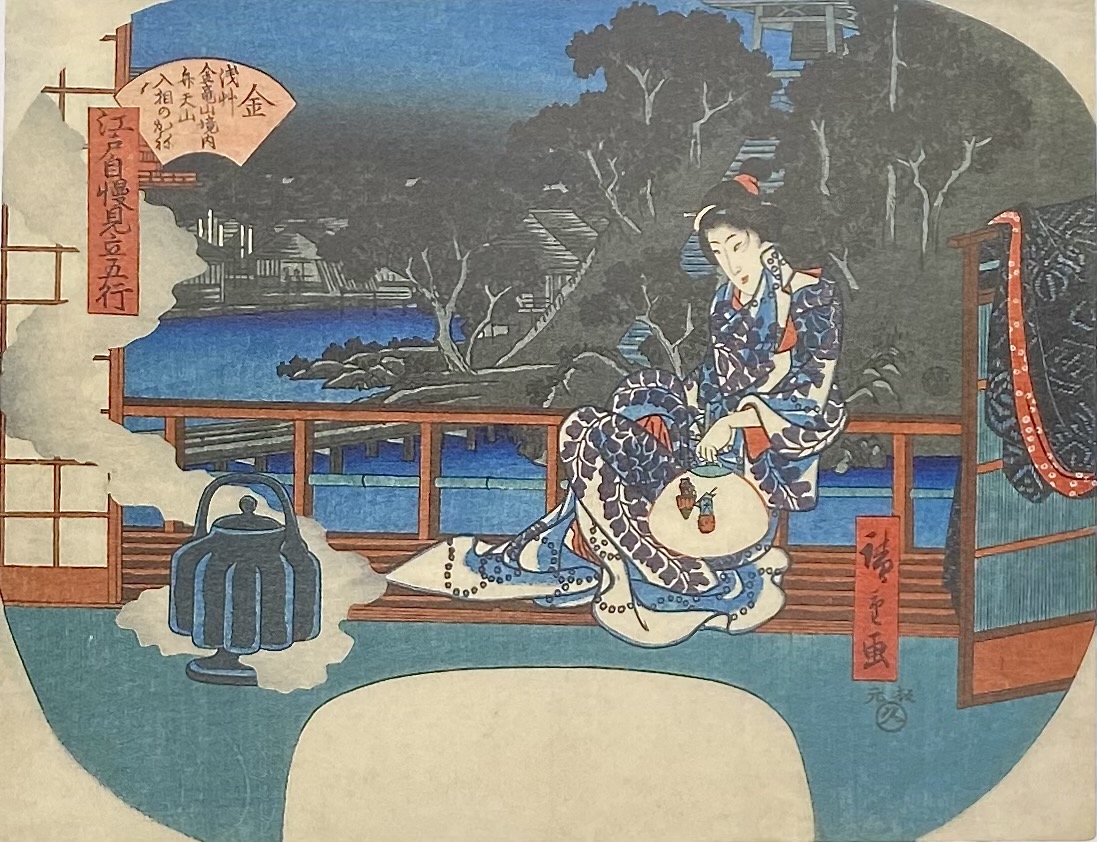
Metal [Izzard, 2020].
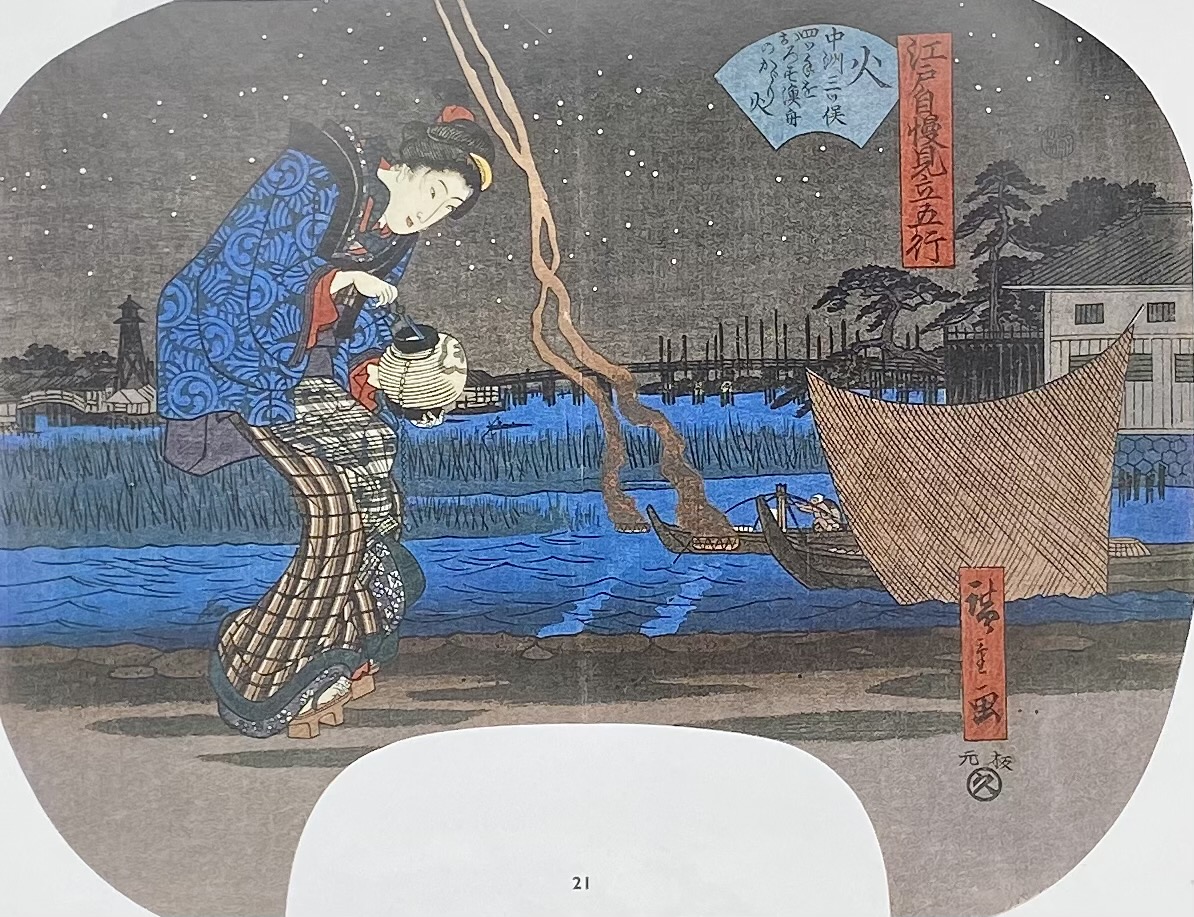
Fire [Faulkner, 2001].
-
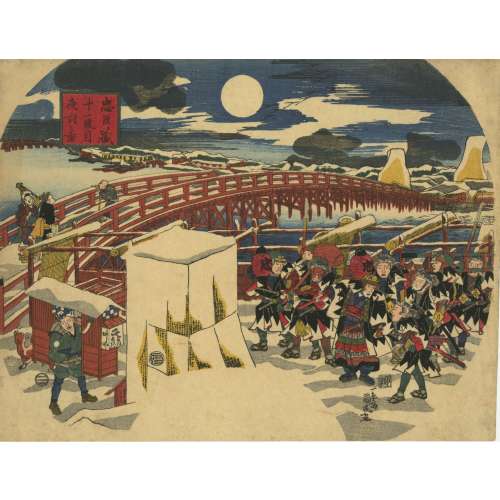 Artist: Utagawa Kunimaru [歌川国丸] (Japanese, 1794 – 1829). Publisher: Ibaya Senzaburō [伊場屋 仙三郎] (fl. 1815 – 1869). Date-kiwame seal: Bunsei 10 (1827). Signed: Ichiensai Kunimaru ga [一円斎国丸画]. Play: Chūshingura [忠臣蔵] (The Treasury of Loyal Retainers), 11th act, Night Battle [十一段目夜討之図]. Act XI: The Attack on Kō no Moronao Mansion. Kō no Moronao [高 師直] (Japanese, d. 1351). Ref: Ako City Museum of History Inscription on the soba peddler box: Nihachi soba udon [二八そば うどん] – twice eight soba and udon (16 mon per serving).
Artist: Utagawa Kunimaru [歌川国丸] (Japanese, 1794 – 1829). Publisher: Ibaya Senzaburō [伊場屋 仙三郎] (fl. 1815 – 1869). Date-kiwame seal: Bunsei 10 (1827). Signed: Ichiensai Kunimaru ga [一円斎国丸画]. Play: Chūshingura [忠臣蔵] (The Treasury of Loyal Retainers), 11th act, Night Battle [十一段目夜討之図]. Act XI: The Attack on Kō no Moronao Mansion. Kō no Moronao [高 師直] (Japanese, d. 1351). Ref: Ako City Museum of History Inscription on the soba peddler box: Nihachi soba udon [二八そば うどん] – twice eight soba and udon (16 mon per serving). -
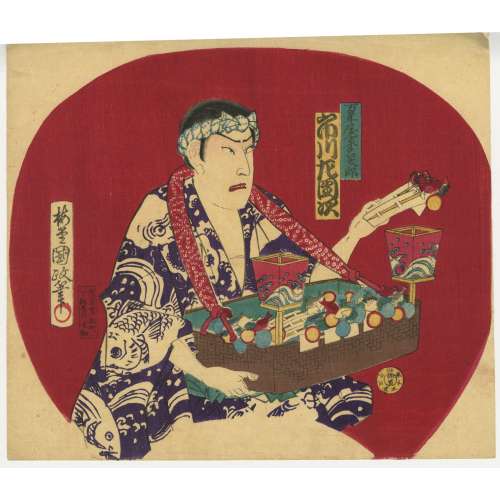 NEW
NEWTitle: Kabuki Actor Ichikawa Sadanji I as Mannenya Kamei Tarō
Artist: Utagawa Kunisada III (Baido Kunimasa) [Japanese, 1848–1920]
Signature: Baidō Kunimasa hitsu (梅堂國政筆)
Actor: Ichikawa Sadanji I (市川左団次, also known as Ichikawa Shōjaku I, Ichikawa Koyone, Ichikawa Tatsuzō) [Japanese, 1842–1904]
Role: Mannenya Kamei Tarō (万年屋家名太郎)
Play: Unidentified
Publisher: Shimōsaya Masukichi (下総屋升吉)
Publisher’s Address: Asakusa, Kurofune-chō (浅草 黒舩)
Date: [明治十三年三月] Meiji 13 (1880), 3rd month
Medium: Uchiwa-e (団扇絵, fan print), ink and colour on paper, 245 × 282 mmThis uchiwa-e (fan print) by Utagawa Kunisada III (also known as Utagawa Kunimasa IV) portrays the kabuki actor Ichikawa Sadanji I in the role of Mannenya Kamei Tarō. The figure is depicted in a dramatic stance, dressed in a striking blue kimono adorned with fish and wave motifs, suggesting a maritime or festival connection. He carries a large basket supported by a fabric strap around his neck, filled with small toy fish attached to sticks, along with round objects that could be festival sweets or miniature decorations. He holds one of these toy fish-on-a-stick items in his right hand, possibly demonstrating it as part of a vendor's performance.
The background is a bold, deep red, contrasting with the detailed rendering of the actor’s expression and costume. The print was published in 1897 (Meiji 30) by Shimōsaya Masukichi, a publisher based in Asakusa, Kurofune-chō. Though the exact play remains unidentified, the composition captures a moment from a kabuki performance where street vendors and festival sellers were often featured as comic or supporting characters in Edo-period narratives.
This work exemplifies the continuation of traditional kabuki actor portraiture into the Meiji period, reflecting both theatrical culture and popular printmaking traditions at the time.
-
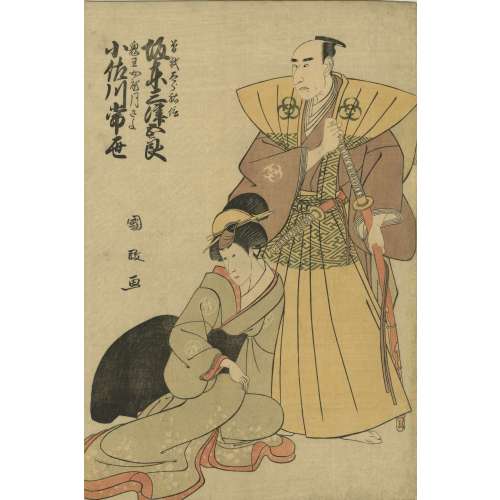 Bando Mitsugoro II as Soga no Taro Sukenobu, the step-father of the Soga brothers, and Osagawa Tsuneyo II as Onio's wife Tsukisayo, in the play 'Omonbi Kuruwa Soga' performed at the Ichimura-za in the 1st month of 1799. Reference: Harvard Art Museums accession number 1933.4.525. Publications: Narazaki Muneshige, Ukiyo-e shuka [Collection of the Masterpieces of Ukiyo-e Prints in Museums] Volume 8: Foggu Bijutsukan [Fogg Art Museum, Harvard University], Neruson Bijutsukan [Nelson Atkins Museum]..., Shogaku-kan (Tokyo, Japan, 1980 [Showa 55]), Color Plate 107; p. 104 (entry p. 191). SOLD
Bando Mitsugoro II as Soga no Taro Sukenobu, the step-father of the Soga brothers, and Osagawa Tsuneyo II as Onio's wife Tsukisayo, in the play 'Omonbi Kuruwa Soga' performed at the Ichimura-za in the 1st month of 1799. Reference: Harvard Art Museums accession number 1933.4.525. Publications: Narazaki Muneshige, Ukiyo-e shuka [Collection of the Masterpieces of Ukiyo-e Prints in Museums] Volume 8: Foggu Bijutsukan [Fogg Art Museum, Harvard University], Neruson Bijutsukan [Nelson Atkins Museum]..., Shogaku-kan (Tokyo, Japan, 1980 [Showa 55]), Color Plate 107; p. 104 (entry p. 191). SOLD



